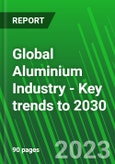Successive events across the worldwide aluminium value chain over the past few years have redirected the industry. The ongoing Russia-Ukraine geopolitical conflict, the energy crisis in Europe, a resurgence of COVID in China followed by power consumption restrictions, and high inflation all over the globe have ensued to production cuts, uneven supply chain, volatile pricing, and unenthusiastic consumption in the downstream sector until the first half of 2023.Global Aluminium Industry - Key Trends to 2030
However, this scenario started changing in the second half of the year as China lifted energy consumption restrictions, European smelters began resorting to renewable energies, and Chinese primary aluminium producers initiated relocation to Yunnan to leverage hydropower. In addition, the increasing awareness of recycling to achieve a circular economy and the vast usage of digital solutions in operations have begun taking the global aluminium industry in a new direction. Production capacities are expanding, new projects are commencing, and consumption is increasing. Moreover, aluminium has recently encountered some very innovative applications in the packaging, building & construction, and automotive industries, which have given a new identity to the metal.
A lot has changed in the industry over the past three years, and thus, it is important to revise our long-term outlook and take a note of the latest trends in the aluminium value chain. With that objective, the publisher has come up with an updated report on ‘Global Aluminium Industry - Key Trends to 2030’. A report on the same topic was first launched in 2020, but now, after three years, we have come up with all-new information based on the changed dynamism of the industry.
In this report, you will learn the latest overview of the aluminium value chain along with a short-term outlook, know about the brand new & trending products and their applications, and future investments across every value chain vertical. This report also sheds light on digital transformation in the aluminium industry, digital solutions used in mining, refining, and smelting, and how they are reshaping the industry as a whole. You can also find the new projects undertaken to achieve sustainability and net-zero carbon emissions within a stipulated time.
The report also discusses new trade policies imposed to protect the domestic aluminium industry in respective countries. Overall, this report will offer you a fair idea of some of the key trends in the global aluminium industry till 2030, based on the ongoing affairs. It will thus help you make a revised decision for your future business plans.
At a glance, the report covers the following topics:
- Background/Report coverage
- Background/Report coverage
- Global Aluminium Industry - An overview & Short-term Trend
- Global Aluminium Industry - An overview & Short-term Trend
- A glimpse into the bauxite sector
- Alumina industry trends
- Overview of the primary aluminium industry
- Downstream market review
- A glance at the end-user sector
- Recycled aluminium segment sneak peek
- New Products & Applications
- High purity alumina
- High purity aluminium
- Low-carbon alumina
- Low-carbon aluminium
- Recycled aluminium with maximum post-consumer scrap - Case Study
- Factors Driving the Growth of the Aluminium Sector
- Aluminium: Trending Products & Applications
- Aluminium applications in the renewable energy industry
- Using aluminium for interior design/fashion
- Harnessing the power of aluminium to supercharge vs sanitisation
- Aluminium batteries
- 3D Printing aluminium
- Geographic Trends
- Key Investments and Future Plans
- Digital Transformation in the Aluminium Industry
- Technology & Industry 4.0 backing up bauxite mining
- Digitalisation in alumina refining, red mud
- Digitalisation transforming primary aluminium, zero-carbon aluminium - inert anode technology
- Sustainability
- Trade Policies
- Conclusion








